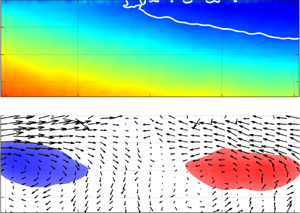Article contents
Periodic forcing of a large turbulent separation bubble
Published online by Cambridge University Press: 11 March 2021
Abstract

The response of a pressure-induced turbulent separation bubble (TSB) to periodic forcing by pulsed-jet actuators (PJAs) positioned in the upstream boundary layer is investigated experimentally in an attempt to elucidate the mechanism of low-frequency contraction and expansion (‘breathing’) already documented in this flow by Mohammed-Taifour & Weiss (J. Fluid Mech., vol. 799, 2016, pp. 383–412). The TSB is generated on a flat test surface by a combination of adverse and favourable pressure gradients and the free-stream velocity is  $25\ \textrm {m}\,\textrm {s}^{-1}$. The results indicate that periodic forcing artificially reduces the size of the TSB by moving separation downstream and reattachment upstream. The smaller TSB is associated with narrower streamwise distributions of average pressure and forward-flow fraction, as well as smaller turbulent stresses in the shear layer bounding the recirculation region. Transient forcing experiments further demonstrate that the TSB responds to upstream forcing with a characteristic time scale that is of the same order of magnitude as that of the breathing motion. Overall, the results of this study support a mechanism whereby the low-frequency breathing motion is a response of the TSB to upstream perturbations that affect the position of separation first and, indirectly, the position of reattachment through a global redistribution of the pressure and velocity fields. The low-frequency behaviour of the TSB appears to be well illustrated by a first-order low-pass filter model that converts the broadband fluctuations of the incoming turbulent boundary layer into a low-frequency, large-scale oscillation of the separation and reattachment fronts, thus leading to a contraction and expansion of the TSB. The results of the continuous forcing experiments also offer new insights into active separation control with PJAs by showing that such actuators generate strong starting vortices that, when convected within an adverse pressure gradient, are associated with a downstream shift of the separation front.
$25\ \textrm {m}\,\textrm {s}^{-1}$. The results indicate that periodic forcing artificially reduces the size of the TSB by moving separation downstream and reattachment upstream. The smaller TSB is associated with narrower streamwise distributions of average pressure and forward-flow fraction, as well as smaller turbulent stresses in the shear layer bounding the recirculation region. Transient forcing experiments further demonstrate that the TSB responds to upstream forcing with a characteristic time scale that is of the same order of magnitude as that of the breathing motion. Overall, the results of this study support a mechanism whereby the low-frequency breathing motion is a response of the TSB to upstream perturbations that affect the position of separation first and, indirectly, the position of reattachment through a global redistribution of the pressure and velocity fields. The low-frequency behaviour of the TSB appears to be well illustrated by a first-order low-pass filter model that converts the broadband fluctuations of the incoming turbulent boundary layer into a low-frequency, large-scale oscillation of the separation and reattachment fronts, thus leading to a contraction and expansion of the TSB. The results of the continuous forcing experiments also offer new insights into active separation control with PJAs by showing that such actuators generate strong starting vortices that, when convected within an adverse pressure gradient, are associated with a downstream shift of the separation front.
Information
- Type
- JFM Papers
- Information
- Copyright
- © The Author(s), 2021. Published by Cambridge University Press
References
REFERENCES
- 24
- Cited by


